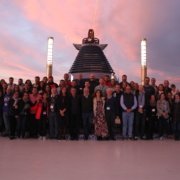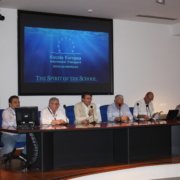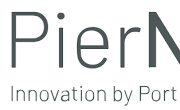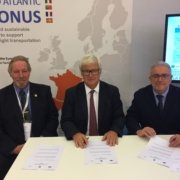MOST Iberia 2018 brings together Spanish, Portuguese and South American professionals
For a second year running, the Escola brought together professionals from Spanish and Portuguese transport enterprises during the MOST Iberia edition of its well-established courses in intermodal maritime transport.
Between the 20th and the 23rd of October, a group comprising 53 professionals from the logistics and port sectors of Spain, Portugal and South America descended onto Barcelona to improve their knowledge of intermodal logistics and the motorways of the sea, and to expand their professional networks. During 4 days on board of a Ro-Pax ferry of Grimaldi Lines linking Barcelona to Civitavecchia, the participants could share their experiences, idiosyncrasies, and knowledge coming from their respective countries.
From Spain the participants came from the Spanish Ports (Puertos del Estado), as well as including logistic operators, transport companies and large associations and corporations from the sector: Roehlig, Casintra, Acotral, JVC Shipping & Solutions, El Corte Inglés and ATEIA. The South American delegation consisted of 25 professionals coming from port communities from Argentina, Bolivia, Brazil, Chile, Colombia, Costa Rica, Ecuador, El Salvador, Guatemala, Honduras, Mexico, Nicaragua, Panama, Peru, the Dominican Republic and Uruguay. Members of public entities such as the regional government of Madeira, the Institute of Mobility and Transport, port authorities of Sines, Algrave, Douro, Leixões and Viana do Castelo, alongside representatives of private companies (Navex and Intermodal Portugal) formed the Portuguese delegation. “Excellent lecturers, an experience that allowed us see transport logistics from different perspectives than the ones we’re used to. All of this while living and experiencing a Mediterranean maritime journey. Thank you for everything” expressed one participant.
The teaching staff comprised: Álvaro Rodríguez Dapena, Planning and Development Director of Spanish Ports (Puertos del Estado); Ana Arévalo, Commercial Manager of SSS at the Port of Barcelona; Antonio Vargas, Ex General Director and current Board Member of Grimaldi Logistics Spain; Eduardo Bandeira, Executive Director of Intermodal Portugal; Raquel Nunes, Promotion and Training Manager and Eduard Rodés, Director of the Escola Europea.
The course developed the concept of co-modality as a tool to improve transport management. The motorways of the sea were shows as fundamental elements of a sustainable logistics supply chain. The course participants have to resolve a case study that evaluates short sea shipping solutions, and applies calculations of direct and indirect costs to determine an optimal transport solution in terms of economic, social and environmental terms.








